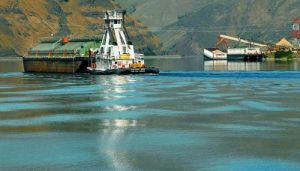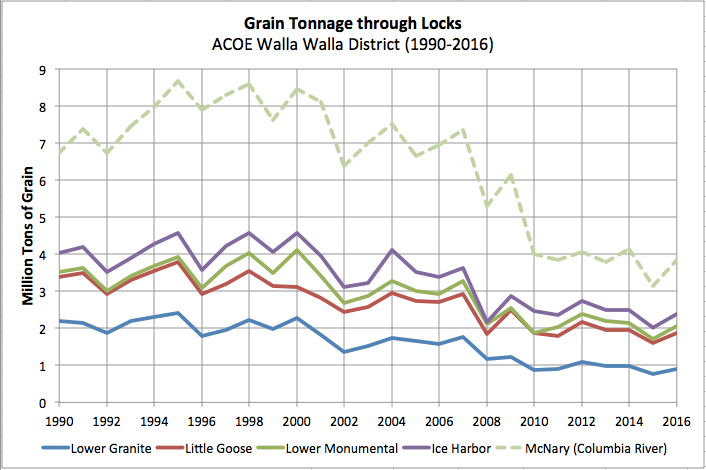forum
library
tutorial
contact

Dredging Up an Ageless Debate
by Eric BarkerLewiston Tribune, November 10, 2013
|
the film forum library tutorial contact |

|
Dredging Up an Ageless Debateby Eric BarkerLewiston Tribune, November 10, 2013 |
With Snake River sediment removal in system's future,
environmentalists want to see some numbers getting crunched first
 The lower Snake River dams were primarily built to establish an alternative way to get inland goods to seaport markets. Now the future of the system could hinge on whether river navigation, and the heavy public investment required to keep it going, still makes dollars and cents.
The lower Snake River dams were primarily built to establish an alternative way to get inland goods to seaport markets. Now the future of the system could hinge on whether river navigation, and the heavy public investment required to keep it going, still makes dollars and cents.
At least that is what critics of the system would like. But thus far, a draft 20-year plan to manage sediment accumulation in the Snake and Clearwater rivers near Lewiston doesn't include a cost-benefit analysis. That has left both critics and supporters of the dams, and the river transportation they make possible, to crunch their own numbers.
Their arguments are based on how much benefit taxpayers receive from maintaining the system. But the real argument is over salmon and steelhead and the effects dams have on the prized sea-run fish.
Since Ice Harbor, Lower Monumental, Little Goose and Lower Granite dams were built - first and foremost to make Lewiston a sea port and secondarily to provide hydropower generation along with a small amount of irrigation and flood control - breaching advocates want to prove the navigation system is antiquated and costly.
 To that end, Kooskia resident and Port of Lewiston critic Linwood Laughy made waves last spring when he calculated the U.S. Army Corps of Engineers would spend $3 million a year over the next two decades to keep the navigation channel near Lewiston deep enough for barges. Earlier this year, Laughy and comrades in the fight to free the river of dams hired a professional economist to shore up his numbers.
To that end, Kooskia resident and Port of Lewiston critic Linwood Laughy made waves last spring when he calculated the U.S. Army Corps of Engineers would spend $3 million a year over the next two decades to keep the navigation channel near Lewiston deep enough for barges. Earlier this year, Laughy and comrades in the fight to free the river of dams hired a professional economist to shore up his numbers.
Comments submitted by him and members of the Save Our Wild Salmon Coalition, which includes several environmental groups, indicate they believe dredging alone will cost $2 million a year and only provide $500,000 to $1 million in annual economic benefit. They also cite other expenses involved in maintaining the river system that include repairs to locks, dredging between Portland and the mouth of the Columbia River and the cost to analyze dredging and other sediment management work.
They say that amounts to federal subsidies for area farmers and shippers - from $11,000 to $18,000 per loaded barge - to get wheat and other products to the Port of Portland. Laughy and his colleagues went on to argue that most products shipped on the river could be moved by truck and rail at the same or even a cheaper cost.
"If you look at what has gone on over the last 15 years with river shipping, the markets themselves are making those decisions and traffic on the lower Snake River is down substantially, way more than you would say is a result of the recession or anything else," said Kevin Lewis of the Boise-based Idaho Rivers United.
They have made much of some agricultural interests' willingness to invest in rail. The Pacific Northwest Farmers Cooperative and the Cooperative Agricultural Producers Inc. recently invested $17 million of private money in the McCoy shuttle train loading facility near Oakesdale. Comments submitted by the environmentalists say that facility and others in eastern Washington will compete with barge transportation and make the river system less efficient.
But that is not the way Bill Newbry, CEO of the Genesee-based Pacific Northwest Farmers Cooperative, sees it. Although he said he understands both sides of the argument, barge, rail and truck transportation are essential for growers to get their crops to market, and attempts by dam opponents to use McCoy as a breaching "poster child" are wrong.
"The McCoy grain terminal shuttle system is a complement to the river system and the river system is a complement to the train system. We need all forms of transportation," he said. "To say that because somebody has built a unit loading facility, there is no need for a barge system, that is erroneous, that is so wrong."
In fact, the cooperative is also heavily invested in the river system. It owns or is part owner of three Snake River barge terminals.
The Pacific Northwest Waterways Association countered the comments of the environmental groups with numbers crunched by its own hired economist.
The industry group claims dredging the river will cost about $800,000 a year and produce a net annual economic benefit of at least $5 million and perhaps as high as $10 million. After a sharp drop to less than 3 million short tons shipped on the river in 2011, a dip they blame on the recession and the winter of 2010-11 when lock maintenance closed the river, they say the number of goods moving via the navigation system is on its way back up and approaching pre-recession levels. Last year 4.6 million short tons moved on the river, according to their data. That is an increase but still less than the average of 5.5 million tons from 2000-2004 and 4.9 million tons from 2005 to 2009 cited in their comments.
 The comments go on to say "there is no evidence that commercial navigation on the lower Snake River is undergoing a long-run decline. In fact, recent shipping volumes show a steep increase in river traffic in 2012 and indicate the river traffic is returning to pre-recession levels."
The comments go on to say "there is no evidence that commercial navigation on the lower Snake River is undergoing a long-run decline. In fact, recent shipping volumes show a steep increase in river traffic in 2012 and indicate the river traffic is returning to pre-recession levels."
"It essentially confirms what we felt we already knew about the benefits of the inland navigation system and specifically how the lower Snake River with the historic tonnage and the tonnage moving today and the prospects for the future," said Pacific Northwest Waterways Association Executive Director Kristin Meira.
But the analysis done by the environmental groups cite a 47 percent decline in shipping volume between 1994 and 2009.
"Most of this decline occurred prior to the onset of the Great Recession and reflects structural trends," according to their comments.
The industry group counters that the time period was cherry-picked and started in 1994, one of the peak years for cargo and concludes in 2009, following a weak harvest and during the recession. They say a wider view, starting in 1983 and extending through last year, shows both peaks and valleys in shipping with an average of about 5.2 million short tons on the river.
The environmental groups are calling on the corps to crunch the numbers. They say the National Environmental Policy Act requires it, as does good governance.
"What are we getting from this system and if we are going to keep it in place as it is today and do all these things to maintain it, is that worth the cost both in terms of economics and in terms of what it is doing to fish versus what it could do if we did something else?" said Steve Mashuda, an attorney with the Seattle office of Earthjustice. "I think that is not only a legal requirement but it is a very legitimate public policy question."
Supporters of river transportation say the request for an in-depth economic analysis on the river system is meant simply to delay dredging and hurt shippers.
"The corps is required to do economic analysis when they construct new projects. This is a project that has been in existence for years," Meira said. "It is merely a maintenance effort the corps is contemplating."
The corps doesn't plan to dive into the numbers. Corps spokesman Bruce Henrickson at Walla Walla said the agency has an obligation to maintain the navigation system that was authorized by Congress. Its 20-year draft Programmatic Sediment Management Plan calls for a number of long-term measures to do that and a short-term plan to dredge about 490,000 cubic yards of sand and silt from the navigation channel and port berthing areas.
The agency would only do a cost-benefit analysis if it had to choose between two tools to accomplish the needed short-term work. But in this case, Henrickson said dredging is the only option the agency has to maintain the navigation channel.
"We are proposing to use the only proven efficient tool, which happens to be dredging. There is no other tool to compare it to," he said. "The justification of the navigation system itself is outside the scope of this EIS - that is not our job. Inside the EIS, the only tool that works is dredging so we didn't do a cost-benefit analysis on that."
If the agency sticks to its plans, a judge may end up making the final call on the matter.
Mashuda said it's premature to say whether they will go to court but he also noted, "I anticipate if the corps sticks to this line of reasoning, this will be an issue that gets tied up going forward."
The environmental groups did file a lawsuit over the corps' last sediment management plan. They ended up settling when the corps agreed to do a much more expansive study. To date the agency has spent $16 million preparing its sediment management plan. The agency had expected to finalize the plan this fall and dredge this winter. It missed that target and the soonest dredging can now happen is next winter.
Related Sites:
Pacific Northwest Waterways Association
Related Pages:
Don't Take Linwood Laughy's Word for It by Marty Trillhaase, Lewiston Tribune, 1/31/13
Analysis Questions Economics of Barging by Eric Barker, Lewiston Tribune, 1/21/13
Electric Power Foregone to Lock Flush by Oregon Natural Resource Council, Restoring the Lower Snake River
Eric Barker
Dredging Up an Ageless Debate
Lewiston Tribune, November 10, 2013
learn more on topics covered in the film
see the video
read the script
learn the songs
discussion forum
